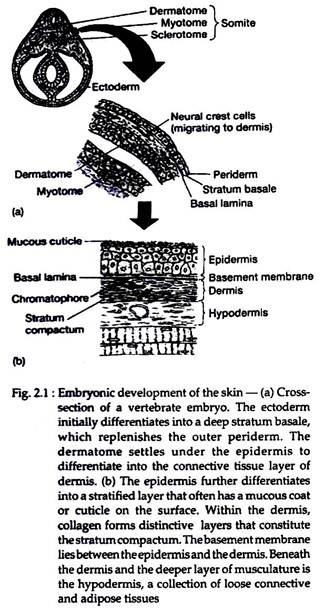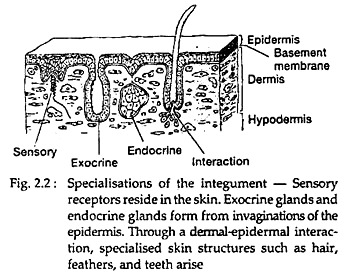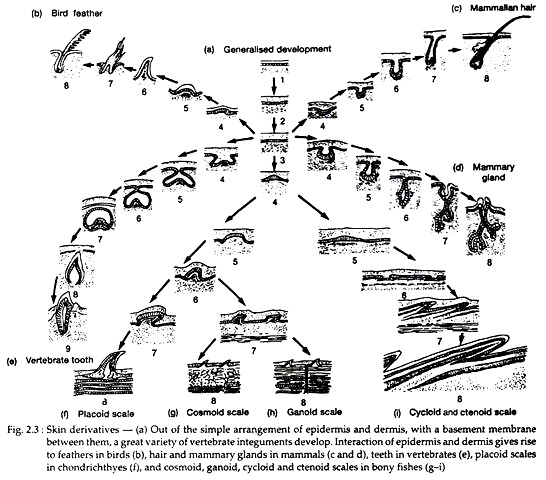In this article we will discuss about:- 1. General Structure of Skin 2. Embryonic Origin of Skin 3. Functions.
General Structure of Skin:
The outermost surface is the epidermis. The epidermis lies on the basement membrane (basal lamina or reticular lamina) as a characteristic feature (Fig. 2.1). Below the basement membrane lies the dermis. The epidermis develops from ectoderm and dermis is derived from mesoderm and mesenchyme.
There is a transitional subcutaneous layer of loose connective tissues and adipose tissues, called hypodermis, in between the integument and deep body musculature.
Embryonic Origin of Skin:
At the end of neurulation in the embryo, the skin precursors are delineated. Single layered ectoderm proliferates to be multilayered epidermis. The deep layer of the epidermis, the stratum basale (stratum germinativum), rests upon the basement membrane (Fig. 2.1).
ADVERTISEMENTS:
The cells of the stratum germinativum divide to form an outer layer called periderm. Additional skin layers are derived from these two layers with the advancement of development.
The dermis arises from several sources, principally from dermatome. The somites divide to form sclerotome medially and the dermomyotome laterally. The sclerotome is the embryonic source of vertebrae and dermomyotome gives rise to myotomes.
The outer layer of the dermomyotome spreads out under the ectoderm as more or less distinct dermatome that differentiates into the connective tissue component of the dermis. Vascularization and innervations are added, along with contributions from the neural crests. This simple structure of the integument gives rise to several ingredients and derivatives (Figs. 2.2 and 2.3).
Functions of Skin:
Skin is the boundary between animal and environment. It is well-known that animals encounter all possible type of atmospheric conditions. Therefore, it has to perform several activities to cope with the various situations.
ADVERTISEMENTS:
Some of the functions are:
i. Protection:
Horny and keratinous epidermis protects the animal from atmospheric problems. Some integumentary derivatives like horns, claws, antlers directly participate in the protection.
ii. Temperature regulation:
Homoeothermic animals regulate their body temperature with the help of skin. They cool their body in summer by evaporation through skin and keeping their body hot by regulating evaporation.
iii. Sensory:
Various receptors present in the skin convey different information to the brain for appropriate action, e.g., heat, cold, pain etc. Hair in most cases act as tactile receptor.
iv. Excretion:
ADVERTISEMENTS:
Some salts and metabolic end products are released through sweat.
v. Synthesis:
Vitamin D is synthesised from the UV light in the ergastarol of skin.
vi. Secretion:
Sebum secreted from the sebaceous gland keeps the skin oily and prevents desiccation. Mammary gland secretes milk in mammals; poisonous gland secretes poison in toads.
vii. Absorption:
Oily covering on the skin prevent easy absorption. However, fat-soluble vitamins can be absorbed through skin.
viii. Osmoregulation:
Sweating, evaporation and diffusion through the skin tremendously help in osmoregulation.
ix. pH balance:
Sweating, diffusion result in movement of salts to and from the body, causing change of pH of the body fluids.
x. Reservoir:
Considerable amount of fat, water, salt and glucose are stored in the dermis.
xi. Gaseous exchange:
In some vertebrates wet skin helps in O2 and CO2 exchange, e.g., toads.
xii. Indicator:
Changes in normal texture of the skin are good indicator of general health of the animal, e.g. vitamin deficiency, malnutrition, aging etc.


